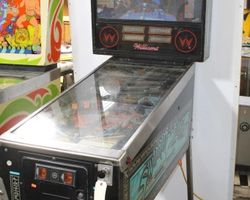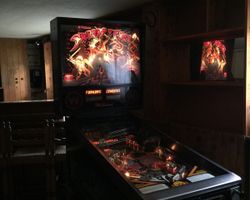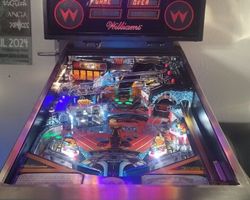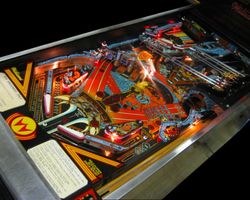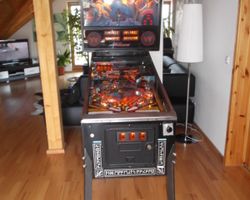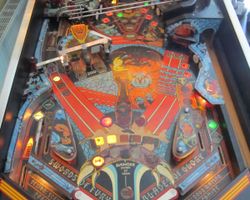Swords of Fury
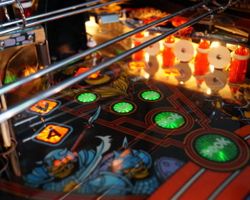
Average Prices: USD $300 to $1,800
Produced: June, 1988
Production Run: 2,705 units
Machine Type: Solid State Electronic
MPU: Williams System 11B
Players: 4
Concept by: Doug Watson
Design by: Tony Kraemer, Steve Kirk
Art by: Doug Watson
Music by: Brian Schmidt
Sound by: Brian Schmidt
Software by: Dan Lee
The late 1980s represented a vibrant era for pinball, and within this period, Williams Electronics Games unveiled Swords of Fury in June 1988. This machine, model number 559, emerged from the Williams System 11B platform, inviting players into a realm of fantasy and medieval combat. Designed to captivate both casual players and seasoned enthusiasts, Swords of Fury combined innovative gameplay mechanics with a rich thematic experience.
History and Background
Swords of Fury was conceived and brought to life by a team of talented individuals within Williams. Doug Watson spearheaded the concept, design, and artwork, creating the visual and thematic foundation of the game. Steve Kirk and Tony Kraemer contributed to the design, ensuring the gameplay was as compelling as the aesthetics. Dan Lee programmed the software that breathed life into the rules and interactions, while Brian Schmidt composed the music and sound effects, crafting an auditory landscape to match the on-screen action.
Interestingly, Swords of Fury holds the distinction of being the last Williams pinball machine to feature a 7-digit scoring system. Adding to its unique character, the machine incorporates Tolkien-esque runes on the cabinet sides, and for high scores, it plays a distinctive Bach fugue. A minor production quirk, potentially uncorrected throughout the run, is the misspelling of "shield" as "sheild" on the left outlane insert. Prototype versions of Swords of Fury also exist, distinguished by red-colored circuit boards under the playfield and hand-drawn graphics beneath the mylar overlay.
Signature Features and Design
Swords of Fury is immediately recognizable due to its distinctive upper playfield. This elevated area, a defining feature of the machine, houses a mini-flipper and a bank of five drop targets. This arrangement is not merely decorative; it is integral to the gameplay, demanding precision and timing from the player. Beyond the upper playfield, a diverter ramp dynamically alters ball paths, adding an element of unpredictability. The inclusion of a kickback on the left outlane provides a crucial second chance, while strategically placed spinners reward skillful shot placement.
Artwork on Swords of Fury contributes significantly to its thematic immersion. Doug Watson's artistic style, while described by some as slightly dark, effectively evokes a fantasy world populated by knights and mythical creatures. The cabinet, backglass, and playfield art work in harmony to create a cohesive visual experience that reinforces the medieval fantasy theme. The sound design is another signature element. Brian Schmidt's soundtrack is frequently cited as a high point, with many considering it among the best sound packages within the Williams System 11 series.
Playfield and Mechanics
The Swords of Fury playfield presents a multi-leveled landscape designed for dynamic ball flow. Four flippers – two standard and one mini-flipper on the upper playfield, along with an additional flipper on the right inlane – offer ample control. The layout incorporates two slingshots, seven standup targets, a five-bank of drop targets on the upper playfield, three spinners, two horseshoe lanes, and a kick-out hole. Notably absent are pop bumpers, a design choice that distinguishes Swords of Fury from many of its contemporaries. A mini-post positioned between the lower flippers adds a subtle layer to ball control and strategy.
The upper playfield is the centerpiece of the design. Successfully navigating the ball to this area and engaging the drop targets is crucial for progression. A unique mechanic associated with these drop targets is their progressively delayed reset. Each time the bank is cleared, the targets take longer to reappear, increasing the challenge and urgency of subsequent attempts. This timed reset mechanism is an innovative feature not commonly found in other pinball machines, adding a layer of difficulty that escalates throughout gameplay.
The playfield artwork complements the medieval theme, with detailed illustrations of warriors, dragons, and fantasy landscapes. The alphanumeric displays provide clear feedback on scoring and game status, maintaining functional clarity amidst the thematic richness.
Gameplay Dynamics
Swords of Fury gameplay revolves around mastering the upper playfield and capitalizing on its unique drop target mechanic. The primary objective is to strategically utilize the mini-flipper to knock down the bank of five drop targets. Completing this bank advances the bonus multiplier and ultimately leads to earning a special. During multiball, clearing the drop target bank activates a roving target, which, when hit, awards a jackpot. The jackpot value is visually represented by a series of lights on the backbox, ranging from 500,000 to 4,000,000 points.
The game features a 3-ball multiball mode, initiated through methods not explicitly detailed on the playfield itself, encouraging exploration and discovery by the player. The bonus system in Swords of Fury is notable for its potential to reach a maximum of 100,000 points, multiplied up to seven times. Interestingly, the bonus can be incremented in small increments, as little as 200 points at a time, through skillful use of the u-turn spinners, allowing for nuanced control over bonus accumulation.
The gameplay is generally fast-paced and engaging, demanding accurate shots and quick reactions. The escalating difficulty of the upper playfield drop target reset ensures that the game remains challenging, even for experienced players. While some players might find repetitive elements in the sound package, the core gameplay loop is designed to encourage replayability through its blend of skill-based challenges and rewarding scoring opportunities.
Reception and Legacy
Swords of Fury has garnered a generally positive reception within the pinball community. Praised for its unique artwork and exceptional sound design, the game is often highlighted as a standout title within the Williams System 11 series. The distinctive upper playfield and its challenging drop target mechanic are consistently cited as strengths, contributing to engaging and memorable gameplay.
However, certain aspects of Swords of Fury have received critique. The speech samples, particularly the recurring "Lionman!" callout, have been described as repetitive and potentially grating over extended play sessions. Some players have noted that once specific shots, such as those required for locking balls for multiball, are mastered, the game can become less challenging. The absence of pop bumpers is another point of contention for some, as they are a common and often desired feature in pinball machines. While the artwork is generally appreciated, opinions vary, with some expressing a preference for more polished or impactful visuals.
Despite these criticisms, Swords of Fury maintains a strong legacy as an underappreciated classic. Its innovative upper playfield design, coupled with a compelling fantasy theme and a well-regarded sound package, has solidified its place as a noteworthy title from the late 1980s pinball era. While its unique drop target mechanic was not directly replicated in subsequent machines, Swords of Fury stands as a testament to the creative design and mechanical innovation characteristic of Williams pinball during this period, remaining a sought-after machine among collectors and a fondly remembered title by enthusiasts.
 Active Auctions
Active Auctions
 Auction Results
Auction Results
| Cost | Location | Date |
|---|---|---|
| USD $3,250 |  Nebraska, United States Nebraska, United States |
11 February, 2025 |
| USD $3,600 |  Michigan, United States Michigan, United States |
27 January, 2025 |
| USD $4,500 |  Arizona, United States Arizona, United States |
14 January, 2025 |
| USD $3,000 |  Florida, United States Florida, United States |
14 October, 2024 |
| EUR €3,850 |  Baden-Württemberg, Germany Baden-Württemberg, Germany |
27 April, 2024 |
| USD $3,000 |  Iowa, United States Iowa, United States |
23 April, 2024 |
| USD $3,250 |  Maryland, United States Maryland, United States |
05 October, 2023 |
| USD $5,000 |  Michigan, United States Michigan, United States |
15 November, 2022 |
| EUR €2,000 |  Berlin, Germany Berlin, Germany |
28 October, 2022 |
| USD $3,200 |  Georgia, United States Georgia, United States |
10 December, 2021 |


Private Policy · Search Website · Contact Us
All trademarks and copyrighted materials remain property of their respective owners.
All other content copyright 2007 - 2025 Pinpedia.

